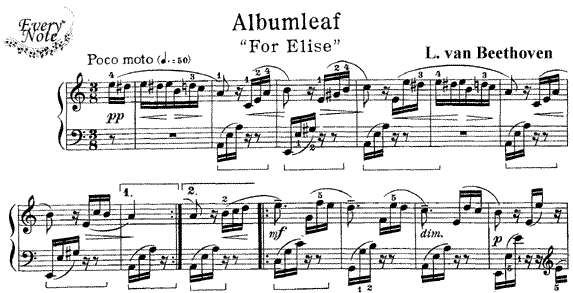June 22 ~ Daily Listening Assignment
Friday, June 22, 2018 by Mary O'Connor | OCMS
Eine Kleine Nachtmusik (Serenade No. 13 for strings in G major), K. 525, is a 1787 composition for a chamber ensemble by Wolfgang Amadeus Mozart. The German title means "a little serenade", though it is often rendered more literally but less accurately as "a little night music." The work is written for an ensemble of two violins, viola, and cello with optional double bass but is often performed by string orchestras and there are many arrangements for other instruments as we will see below.
Part of a full orchestral score:
Follow the score...
Easy piano sheet music might look like this:
The first movement of Mozart's Eine Kleine Nachtmusik, with a graphical score.
One of my favorites, Barbershop-Style. Eine Kleine Not Musik by the Gas Houe Gang tells the story of The Magic Flute (from June 19) to the music of Eine Kleine Nachtmusik.
A piano transcription
For four recorders, all played by the same person
From the Muppets: The Great Gonzo performing Eine Kleine Nachtmusik on bagpipe while sitting on a ten-foot pole!
When my son and I played Eine Kleine Nachtmusik arranged for 2 pianos on November 30,
Find this arranged for piano in Piano Pronto: Movement 2, Movement 3, Encore, Coda and Mozart: Exploring His Life and Music,
June 21 ~ Daily Listening Assignment
Thursday, June 21, 2018 by Mary O'Connor | OCMS
Today's listening assignment is Can-can from "Orpheus in the Underworld" by Jacques Offenbach. This piece is very often in early method books because of the descending C Major scale. Can you find it?
The can-can (or cancan as in the original French) is a high-energy, physically demanding dance that became a popular music hall dance in the 1840s, continuing in popularity in French cabaret to this day. Originally danced by both sexes, it is now traditionally associated with a chorus line of female dancers. The main features of the dance are the vigorous manipulation of skirts and petticoats, along with high kicks, splits, and cartwheels.
Many composers have written music for the cancan. Today's selection is the most famous of these.
A 'follow-along" video. This key has 6 flats, so the scale will be in what key?
Flute ensemble:
The original, for full orchestra
An animation
A dog barking the can-can?
Find this in many student books including Piano Pronto: Movement 1
Have you ever noticed the rug by the piano?
June 20 ~ Daily Listening Assignment
Wednesday, June 20, 2018 by Mary O'Connor | OCMS
Today's piece is one of those that piano students often try to learn on their own - or a friend will teach them the first 9 notes. It's usually played too fast and, often in the wrong octave, or the first couple notes are repeated too many times.
This is one of two pieces that are so often played incorrectly that they have the distinction of being banned from competition in Northern Virginia Piano Teacher competitions.
Stay tuned for the other one!
Fur Elise was not published during Beethoven's lifetime, having been discovered by Ludwig Nohl 40 years after the composer's death. The identity of "Elise" is unknown.
The very basic melody:
The actual beginning is a little more involved.
And, there's more!
If you'd like to learn to play this piece correctly, find the sheet music at IMSLP, Beethoven: Exploring His Life and Music, and countless compilations of classical music available at the O'Connor Music Studio.
Follow along:
By Valentina Lisitsa:
Ragtime!
A variety of instruments (Piano, Guitar, Cat Piano, Cello, Launchpad, Ukulele)
The Big Piano at FAO Schwartz in NYC:
Glass harp:
Youtube has many, many more versions. Beethoven would probably go nuts!















